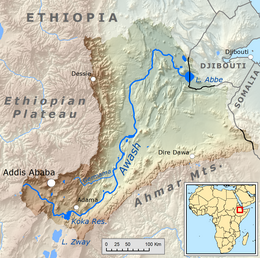
Back Awashrivier Afrikaans አዋሽ ወንዝ Amharic نهر أواش Arabic Avaş çayı Azerbaijani Аваш Byelorussian Аваш (река) Bulgarian Riu Awash Catalan Āwash Wenz CEB Awaš (řeka) Czech Awash Danish
| UNESCO World Heritage Site | |
|---|---|
 Map of the Awash drainage basin | |
| Location | Ethiopia |
| Criteria | Cultural: (ii)(iii)(iv) |
| Reference | 10 |
| Inscription | 1980 (4th Session) |
The Awash (sometimes spelled Awaash; Oromo: Awaash OR Hawaas, Amharic: ዐዋሽ, Afar: Hawaash We'ayot, Somali: Webiga Dir) is a major river of Ethiopia. Its course is entirely contained within the boundaries of Ethiopia and empties into a chain of interconnected lakes that begin with Lake Gargori and end with Lake Abbe (or Abhe Bad) on the border with Djibouti, some 100 kilometres (60 or 70 miles) from the head of the Gulf of Tadjoura. It is the principal stream of an endorheic drainage basin covering parts of the Amhara, Oromia and Somali Regions, as well as the southern half of the Afar Region.
The Awash Valley (and especially the Middle Awash) is internationally famous for its high density of hominin fossils, offering unparalleled insight into the early evolution of humans.[1] "Lucy", one of the most famous early hominin fossils, was discovered in the lower Awash Valley.[1] For its paleontological and anthropological importance, the lower valley of the Awash was inscribed on the UNESCO World Heritage List in 1980.[1]
- ^ a b c "Lower Valley of the Awash". UNESCO World Heritage Site. United Nations Educational, Scientific, and Cultural Organization. Retrieved 18 September 2021.
© MMXXIII Rich X Search. We shall prevail. All rights reserved. Rich X Search